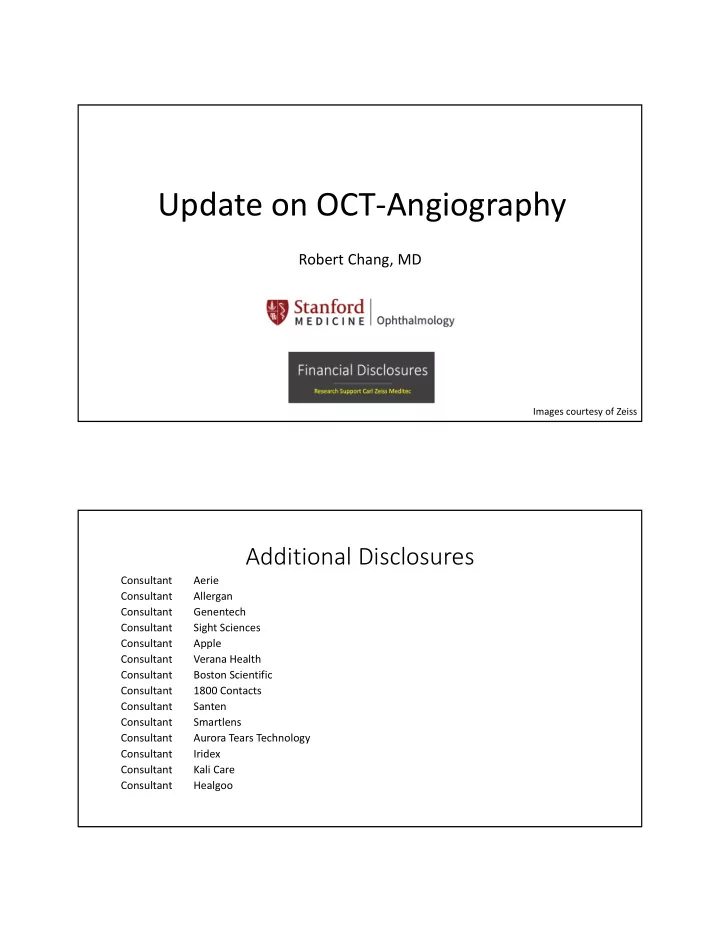

Update on OCT‐Angiography Robert Chang, MD Images courtesy of Zeiss Additional Disclosures Consultant Aerie Consultant Allergan Consultant Genentech Consultant Sight Sciences Consultant Apple Consultant Verana Health Consultant Boston Scientific Consultant 1800 Contacts Consultant Santen Consultant Smartlens Consultant Aurora Tears Technology Consultant Iridex Consultant Kali Care Consultant Healgoo
What is OCT‐A? AngioPlex 3x3 • New, Non‐invasive Approach to Imaging Retinal Vasculature • Launched by CZM Angioplex 2015 (OMAG 2011 Ruikang Wang) optical microangiography (OMAG) • and Optovue AngioVue 2016 (SSADA 2012 David Huang) split‐spectrum amplitude decorrelation angiography (SSADA) AngioPlex Montage 14x14 How Does OCT‐A Work? Visualization of flow without contrast (isolate what is moving) • Combines amplitude and phase information to detect changes in OCT signal through time of moving structures (e.g. RBC’s) OMAG ‐ Zeiss Amplitude only (SSADA) ‐‐ Optovue • Higher sensitivity to slower blood flow • Better microvascular details
AngioPlex OCT Angiography from ZEISS AngioPlex Technology AngioPlex Maps Fast axis x y 0 y 1 y 2 y 3 B‐scan y • AngioPlex Technology detects motion of scattering AngioPlex Maps consist of particles such as red‐blood cells within sequential OCT B‐ reconstruction of the perfused scans performed repeatedly at the same location of the microvasculature within the retina and retina. choroid. Key = Correction of EYE MOTION! Retinal Vascular Maps AngioPlex Maps = 2D En Face Slice of retinal vasculature, B‐scans stacked Superficial Retina Map Deep Retina Map Avascular Retina Map 1 2 3 Avascular region of the retina in healthy Visualization of blood flow in superficial Visualization of blood flow in deep eyes. Allows for detection of abnormal retina. retina. vascular growth.
AngioPlex Color Depth Map The color depth map combines superficial, deep and avascular retina maps and allows for depth visualization of retinal blood flow. Unable to do this with fluorescein angiography… Color Depth Retina Map Superficial Retina Deep Retina Avascular Retina Why Should We Care About Blood Flow in Glaucoma? • It is related to the underlying pathology through multiple studies on individual and population level • Also prior imaging modalities, i.e. doppler ultrasound, dopper flow, laser speckle flowgraphy all showed reduced flow in glaucoma vs. normal Figure re 1 1. 6 x 6-mm superficia icial v l vascular c scular complex ( mplex (SVC) VC) O OCT a angiog iogram am ( (left) t) and 6 6 x 6-mm g mm ganglion c lion cell com complex thi x thickn knes ess map ( s map (rig ight) ) of of a a typi typical glau glaucomato tous eye. eye. T The glau e glaucoma dama mage ( (yel ellow w dash shed outl ed outline) e) was mos was mostly outs outside the centra e the central 3 3 x x 3-mm 3-mm area ( area (the he red red out outline). e). KEY = KEY = lar larger scan scan are area size size t to see see more more Mini nimum u m useful si eful size 6 ze 6 x 6 mm m macula acula How However, is is the the vesse vessel dr dropout a t a cau cause se or or ef effect?
What Are the Advantages of OCT‐A? 1. Non‐invasive – no dye Can be obtained 2. Rapid (few seconds) frequently 3. Presence on regularly used • Useful for longitudinal assessments SD‐ OCT platform • Better vascular detail • Depth resolved • Automated, quantitative “vessel density” and flow Limitations of Current Glaucoma Imaging • OCT RNFL and Macula diffuse loss – hard to measure change • FA = Poor visualization of fluorescein the circulation outside the macula • e.g. near optic nerve head
AngioPlex for ONH Visualization of ONH Perfusion New AngioPlex ONH scan (4.5 x 4.5 mm) Visualization of the Radial Peripapillary Capillary (RPC) Network “Perfusion Density” Normal Eye Advanced Glaucoma Glaucoma OCTA RNFL AngioPlex for ONH reveals blood vessels at the lamina cribrosa level and highlights late stage cupping as in the advanced glaucoma image above. Superficial OCTA enface Superficial OCTA enface Existing AngioPlex 8x8 New HD AngioPlex 8x8
Is OCT‐A Helpful in Clinical Practice Right Now? •How does it compare with OCT RNFL and Macula Quantitative Measurements? •Is there an advantage in cases before RNFL change or after RNFL no longer decreases (floor effect)? From Pretty Better than RNFL for early glaucoma vs normal, based on disc and peri‐papillary vessel density and flow… Pictures to Yarmohammadi A et al. Ophthalmol 2018;125:578. Akil H et al. PLOS ONE 2017;12:e0170476 Repeatable Improved Diagnostic Accuracy with the Macula Superficial Measures Vessel Density… Takusagawa HL et al. Ophthalmal 2017;124:1589) Correlates with VF loss better than RNFL… Liu L et al. JAMA Ophthalmol 2015;133:1045 More sensitive for advanced glaucoma cases… Yarmohammadi A et al. Ophthalmol 2016;123:2498 High‐Definition (HD) Angio 12 x 12mm now possible on Plex Elite 9000 v 2.0 • 200kHz provides widefield, high‐resolution 12 x 12mm with 6mm scan depth 100kHz 200kHz 24µm Sampling Resolution 15µm Sampling Resolution The topics to be discussed include ideas and concepts under development which may be subject to 510(k) clearance and subject to change
Ultra High‐Definition (UHD) Spotlight • Normal Eye ‐0.50DS 100kHz ‐ 3mm Scan Depth 200kHz – Increased 6mm Scan Depth 16 µm Lateral Sampling Resolution 8 µm Lateral Sampling Resolution 3mm mode 6mm mode The topics to be discussed include ideas and concepts under development which may be subject to 510(k) clearance and subject to change 100kHz Imaging Optic Nerve Structures Lamina Cribrosa AngioPlex Map Enface Map RPE +75 / RPE +115 RPE +75 / RPE +115
• Requires Motion Correction • Upgrade the Cirrus 5000 to include Angioplex capability • Needs hardware upgrade for 68,000 A‐scans, 2.0 What Kind of mm depth • Cirrus 6000 100KHz (swept source speed), 2‐2.9 mm Machine Do depth • Angioplex HD You Need for • Optovue AngioVue 70,000 A scans, 2‐3 mm depth OCT‐A? • Angiovue HD • Vessel Mapping Density Numbers • FAZ and superficial/deep plexus trend • Topcon OCT‐A pending • Other Manufacturers
Recommend
More recommend